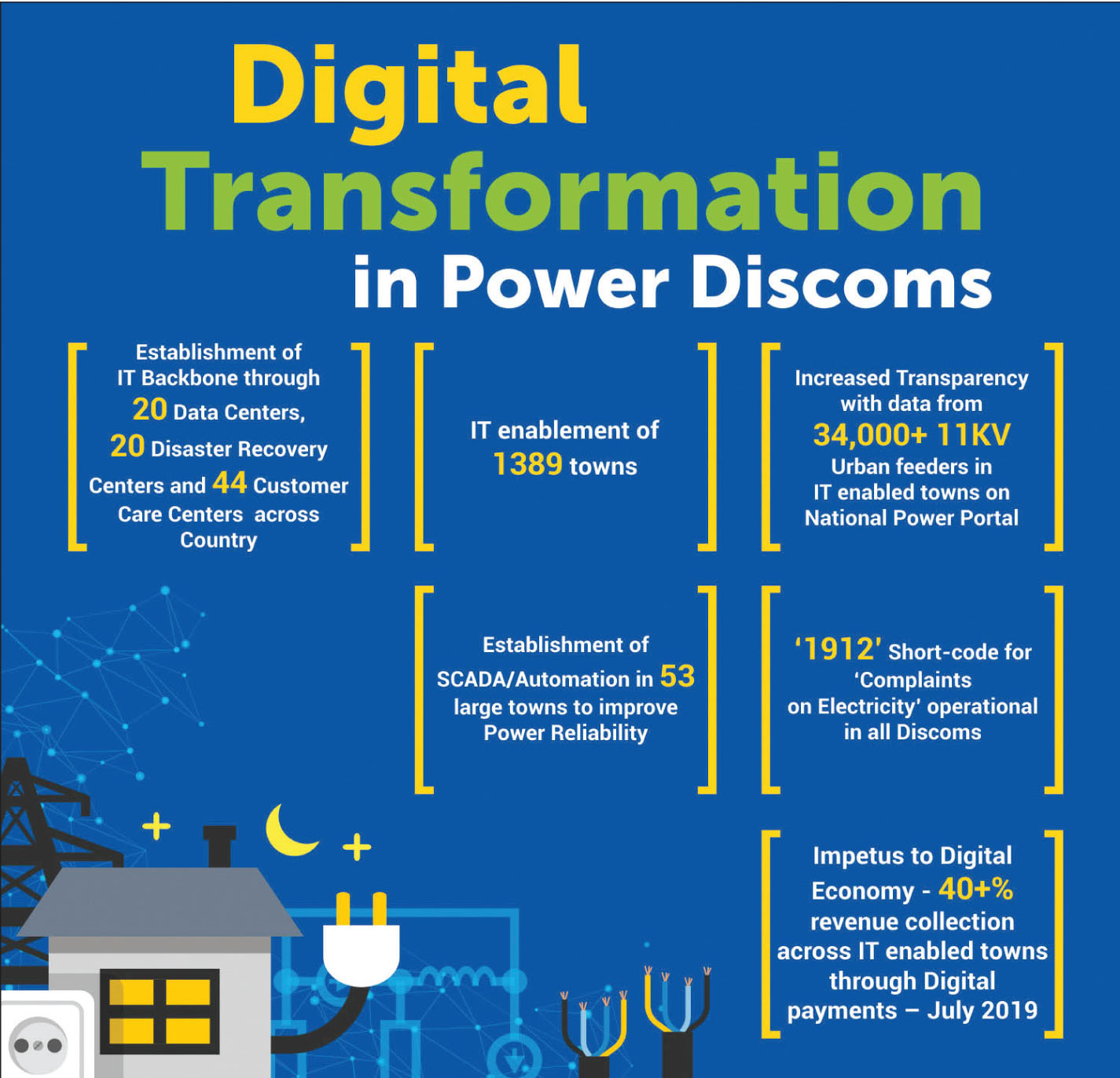The Integrated Power Development Scheme (IPDS), the Ministry of Power’s flagship scheme for strengthening of the sub-transmission and distribution network in urban areas, has progressed well since its launch in December 2014. The scheme has helped in the digital transformation of discoms through initiatives such as implementation of the supervisory control and data acquisition (SCADA) system across large towns, and setting up of data centres and disaster recovery centres. Further, IT-enablement under the scheme has been expanded to another 2,000 towns, and discoms are undertaking enterprise resource planning (ERP) and deploying real-time data acquisition systems. These IT initiatives have helped them improve their operational performance, enhance the reliability of power supply and lower network losses, among other things.
Overview of IPDS
Broadly, the IPDS aims to provide 24×7 power supply to all urban consumers and reduce the aggregate technical and commercial losses of discoms. It comprises three components – strengthening of the sub-transmission and distribution network, metering of distribution transformers/feeders/consumers, and IT-enablement and distribution works that were part of the Restructured Accelerated Power Development and Reforms Programme. The first component entails strengthening of the distribution network at the 33 kV and 11 kV voltage levels, augmentation of distribution capacity, and laying of aerial bunched cables (ABCs) and underground cables for congestion management and theft reduction, to ensure better availability of power for consumers. Meanwhile, IT-enablement of the distribution sector will improve consumer services and enhance operational efficiency of discoms. This involves initiatives such as adoption of IT applications for consumer meter reading and billing, centralised IT-enabled customer care centres, provision of a universal customer support number “1912”, launch of an online payment mechanism for consumers, and deployment of ERP systems for improved operational efficiencies. Apart from these initiatives, the scheme entails replacement of electromagnetic meters with tamper-proof electronic, smart or prepaid meters.
 In terms of financial outlay, a total project cost of Rs 320.59 billion has been sanctioned under the IPDS. This includes central government support of over Rs 200 billion. Component-wise, Rs 282.6 billion has been earmarked for sub-transmission and distribution strengthening, Rs 28.21 billion for IT and OT projects (such as IT-enablement of towns, ERP and smart meters) and Rs 9.78 billion for new technologies (such as gas-insulated switchgear substations).
In terms of financial outlay, a total project cost of Rs 320.59 billion has been sanctioned under the IPDS. This includes central government support of over Rs 200 billion. Component-wise, Rs 282.6 billion has been earmarked for sub-transmission and distribution strengthening, Rs 28.21 billion for IT and OT projects (such as IT-enablement of towns, ERP and smart meters) and Rs 9.78 billion for new technologies (such as gas-insulated switchgear substations).
With regard to progress under the IPDS, system strengthening works have been completed in 336 out of 546 circles. Further, distribution infrastructure has been upgraded in around 2,000 towns benefiting around 30 million consumers. Apart from this, some of the infrastructure set up under the scheme includes 773 power substations (33/11 kV), 27,000 ckt. km of overhead lines, 57,000 ckt. km underground/ABC, and 48,000 new distribution transformers. Overall, at the all-India level, 73 per cent of physical work envisaged under the scheme has been completed.
Digital transformation under the IPDS
Under the IPDS, in order to digitally transform the operations of the power discoms, 20 data centres, 20 disaster recovery centres and 44 customer care centres have been set up across the country. IT-enablement has been completed across 1,389 towns, and data from over 34,000 11 kV urban feeders in IT-enabled towns is available on the national power portal. SCADA has been established in 53 large towns to improve power reliability. Apart from this, short code 1912 for registering electricity-related complaints has been made operational in all discoms. Notably, over 40 per cent revenue across IT-enabled towns was collected through digital payments in July 2019.
 Recent initiatives under IPDS
Recent initiatives under IPDS
The digital initiatives under the IPDS have now been expanded to 2,000 more towns across 24 states. These towns are covered by 45 discoms with 9,000 feeders. Broadly, IT Phase II entails deploying software modules to smaller towns, providing hardware to access the software applications, rolling out metering, billing and collection software, undertaking energy audits, performing GPS-based geographic information system survey of assets, and upgrading data and disaster recovery centres.
With regard to the progress under IPDS Phase II, work has been completed in two states (Andhra Pradesh and Uttarakhand). Contracts have been awarded in nine other states (Haryana, Himachal Pradesh, Kerala, Maharashtra, Odisha, Punjab, Telangana, Uttar Pradesh and West Bengal) and are envisaged to be completed by March 2020. Besides, a request for proposal (RfP) has been floated in five states (Chhattisgarh, Gujarat, Karnataka, Madhya Pradesh and Mizoram). Another new initiative under the IPDS is implementation of ERP at discoms to ensure business excellence. This involves the deployment of IT initiatives in the areas of human resource management, finance and accounts, and purchase and stores. This is being implemented in 39 discoms across 25 states. So far, work has been completed in Andhra Pradesh, Karnataka (Chamundeshwari Electricity Supply Corporation), Jharkhand and Madhya Pradesh. Besides this, work has been awarded in nine states (Himachal Pradesh, Kerala, Maharashtra, Odisha, Punjab, Rajasthan, Telangana, Tamil Nadu and Uttar Pradesh), and RfPs have been floated in six states (Chhattisgarh, Gujarat, Haryana, Nagaland, Tripura and Uttarakhand). Another new component under the IPDS is the establishment of real-time data acquisition (RT-DAS) systems in 2,435 towns. These towns cover 5,834 substations across 33 discoms in 20 states. RT-DAS entails setting up of mini feeder remote terminal units at substations as well as establishment of standardised protocols and modbus with multifunction transducers. Besides, it entails compliance with cybersecurity norms.
With regard to progress under RT-DAS, work has been awarded to Eastern Power Distribution Company of Andhra Pradesh), Madhya Pradesh Madhya Kshetra Vidyut Vitran Company Limited and a Mizoram discom. Meanwhile, RfPs have been floated in Andhra Pradesh (Andhra Pradesh Southern Power Distribution Company Limited), Assam, Bihar, Goa, Haryana, Himachal Pradesh, Jammu & Kashmir, Kerala, Maharashtra, Odisha, Rajasthan, Telangana, Uttar Pradesh and Uttarakhand.
Challenges in digital transformation
One of the key challenges of digital transformation under the IPDS is the lack of project ownership. This hampers the operational performance of projects. Further, there is a serious shortage of skilled manpower in the power distribution segment with old hands unwilling to learn new technologies. The data centres and disaster recovery centres also face capacity constraints. Some of the other issues in the implementation of IT initiatives pertain to operations and maintenance of field equipment, operational expenditure under annual technical support/annual maintenance contracts, and presence of multiple billing agencies for smaller towns/rural areas. Apart from this, cybersecurity threats are a major challenge in IT-enablement of discoms. A cybersecurity mechanism must be put in place to maintain a stable and robust power grid.
Conclusion
Overall, with the changing energy landscape, the traditional business model of state utilities needs to be disrupted. Utilities need to adopt best-in-class IT-OT solutions, which can help optimise business processes, enable informed decision-making, support effective network management and improve customer service. There are exciting new developments in big data, analytics, cloud and mobility, which can help in the integration of renewable energy into the grid, enhance customer engagement, enable accurate load forecasting, and ensure greater reliability of power supply in the country.
Given that utilities are digitalising their critical infrastructure with advanced technology applications and adding more IP gateways and other data delivery elements to their networks, data is becoming more susceptible to cyberattacks. Therefore, having proper cybersecurity measures in place is crucial. The government has taken cognisance of these issues and its efforts are expected to create a more secure and modern power grid.
Based on a presentation by Palka Sahni, Executive Director, Power Finance Corporation, at a recent Power Line conference
